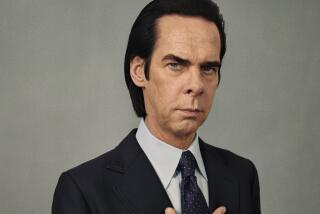Therapy for People Who Suffered Severe Head Injuries : Singer-Songwriter Turns Music Into a Healing Art
- Share via
GALLATIN, Tenn. — Loney Hutchins gets his guitar out of the case, sits at a table and begins singing a tune written by a lady who is lucky to be alive:
I could kiss your lips all night.
Hold you in my arms with all my might.
It’s you who taught me
The taste of love.
Across the table, Tammy Mitchem softly sings along with the words she wrote. “It’s pretty good if I do say so myself,” she said.
The 27-year-old woman from Gastonia, N.C., spent 2 1/2 months in a coma following a traffic accident in February, 1987. While driving to get horse feed, she was struck by a drunken driver in Bessemer City, N.C.
For the past 10 months she has participated in music therapy under the direction of Hutchins, a singer-songwriter and former associate of Johnny Cash.
She is among about 25 people who have suffered severe head injuries receiving individual and group music therapy from Hutchins at Cedarbrook, a private treatment facility 40 miles northeast of Nashville.
“These people could be vegetating without this facility,” says Hutchins.
Patients start by listening to music, then graduate to singing or composing. Some go on field trips to perform.
Patients receive 1 to 1 1/2 hours of group music therapy once or twice a week. Individual music therapy sessions last 30 minutes to one hour once or twice a week.
Patients also participate in programs such as art therapy, physical therapy and speech therapy.
Some of the patients are in wheelchairs. Most live in dormitories at the facility, which is operated by Rebound Inc.
Hutchins said writing songs allows patients to express guilt, anger, fear, humor, love, loneliness, rejection and pain. Composing also helps them to rebuild their vocabulary and functions such as analysis, problem solving and categorization.
Singing can aid articulation, timing, pitch, volume control, vocal quality and inflection.
Other skills helped include reading, memory, attention span, social interaction, pragmatics and sequencing.
Mitchem is among those who have made great strides, Hutchins said.
“She came reluctantly,” he said. “She wouldn’t look at me and would keep her head down. There was no interaction, no smile, no responses to my questions.
“She stayed four or five months, then she bloomed. She raised her head and began smiling. At the discussion sessions, it was exciting when she spoke.
“Now she can take a topic and address it verbally and can remember week to week what we’ve done.
“She sings now and memorizes words to the songs. She is a very positive member of our group.”
Another patient, Gena Hines, 26, of Gainesville, Ga., spent 5 1/2 months in a coma after a 1981 car accident.
“In group (therapy), I enjoy it,” she said. “When we are making words, it gets notions in your mind. Others speak out, and we all get a good song going. Even though verses are not related, the chorus gets it going.”
She said she can see physical improvement in others during music sessions.
“Some of them are physically handicapped, but I see them tapping with their hand or leg.”
Hutchins, 41, said music is excellent therapy for head injuries.
“It’s my theory that everyone wants to write a song. Music is the universal communicator. It fulfills the need to be a viable person. It soothes the frustration, the anger.
“In our society, the whole world teaches us to discourage the creative aspect of our lives: ‘You can do this, you can’t do that.”’
Hutchins could make more money spending all his time as a professional songwriter and performer, but says “this is too good to give up.”
“A lot of entertainers are miserable because there’s no balance in their lives,’ he said. “It’s very rewarding as far as what you get back. Nothing in music compares.”
Patients at the center have written a tune that has become their theme. It is called “Second Chances” and two key lines are:
Why should I frown? One day I’ll wear a starry crown.
I’m so glad I had a chance to survive.
More to Read
Sign up for Essential California
The most important California stories and recommendations in your inbox every morning.
You may occasionally receive promotional content from the Los Angeles Times.









